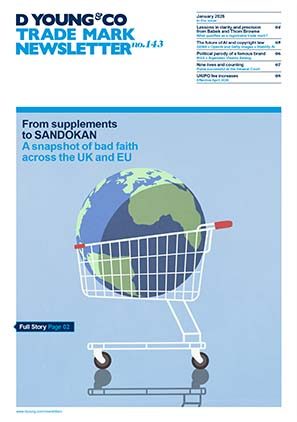Swatch v Samsung: time for more content review?
The UK High Court recently held that the Samsung Electronics Group infringed Swatch’s trade marks by making infringing third party watch face apps available on its app store. Most notably, Mrs Justice Falk found that Samsung was liable as primary infringer, that it had used the infringing signs in the course of trade, and that by conducting a content review of third party apps it had equipped itself with actual knowledge of the infringements.
Background
The judge noted that since 2015 Samsung’s smartwatches, much like conventional watches, had been round in shape and had a bezel (unlike, for example, Apple’s square watches). These smartwatches had also specifically been marketed for their “watch-like” qualities.
Between October 2015 and February 2019, 23 of the Swatch group’s EU trade marks (including GLASHÜTTE, JACQUET DROZ, BREGUET, BLANCPAIN, OMEGA, LONGINES, TISSOT, HAMILTON and SWATCH) were included in 30 watch face apps made available in the Samsung Galaxy App (SGA) store, including the examples below. The apps had been downloaded around 160,000 times in the UK and EU.

Each of the apps was created by a third party app developer and added to the SGA store following Samsung’s technical and content review process. The content review had been conducted by a team of 14 individuals based in Vietnam, each of whom had each been instructed to review at least 85 apps per day against Samsung’s internal content guide (this roughly amounted to 5-10 minutes per app).
The content guide included only three paragraphs of generic guidance on third party rights. It did not mention any watch brands or specifically advise reviewers about apps for smartwatches. The guide also did not clearly instruct the reviewers to conduct an internet search or check any trade mark database.
Swatch demanded that the infringing apps be taken down on 21 December 2018, and Samsung removed all of the apps by 09 January 2019. Swatch subsequently issued proceedings in February 2019 on the basis of trade mark infringement by Samsung as a primary tortfeasor under articles 9(2)(a), 9(2)(b) and 9(2)(c) of Regulation 2017/1001 (the EU Trade Mark Regulation), alleging that Samsung was “intimately involved in, and controlled, the whole process by which the apps were made available”.
Samsung denied liability, pointing out, among other things, that it had not “used” the marks, and that it had a complete defence as an information society provider under Article 14 of Directive 2000/31/EC (the e-Commerce Directive).
Infringement
The court considered that the average consumer is the general public, namely persons who acquire watches and/or smartwatches, who may not necessarily be familiar with app stores and who may not understand that the majority of apps available via the SGA are not connected with Samsung. Moreover, the average consumer would understand the apps available in the SGA store to carry an “implicit assurance” that Samsung has approved them.
The case on “use”
Mrs Justice Falk broadly summarised the legal position on trade mark use (as set out in the Google France v Louis Vuitton Malletier, L’Oreal v Ebay, and Coty v Amazon decisions) as follows:
- Use involves active behaviour on the part of an information service provider;
- Allowing its client to use a mark does not amount to use of the mark by an online marketplace;
- Simply creating the technical conditions necessary for a third party to use a mark does not mean that the party offering that technical service itself uses the sign; and
- To establish use, it is necessary for an economic operator itself to pursue the aim of offering goods or putting them on the market.
Samsung pointed out that use and display of signs on the website of an electronic marketplace is not use by its operator “any more than their use in classified newspaper ads is use by the newspaper”. The tech giant also argued that validating third party apps did not amount to use since the apps were developed and uploaded to the SGA store by third parties. Swatch disagreed, noting the active behaviour and control by Samsung which went beyond merely enabling customers to display signs.
The judge considered Samsung’s behaviour as a whole, bearing in mind the fact that it marketed its smartwatches as “truly watch-like”, and that it made a commercial choice to only create 17 “official” Samsung watch face varieties, thus encouraging third parties to develop the majority of the watch face apps available on the SGA store. All apps, including the Samsung watch face apps, were grouped together in the SGA store, and the average consumer would therefore consider the third party apps to constitute an “optional alternative”. The court held that this was indicative of a symbiotic relationship between Samsung and the app developers, which benefitted both parties and went well beyond revenue derived from app sales.
It was also noted that Samsung provides help to developers via the Galaxy Watch Studio tool, hosting developer conferences and entering into licensing agreements with app developers, all of which made sure that any apps available via the SGA store were of high quality. Overall, the Judge considered that the SGA store is not “just” an online marketplace, and that Samsung’s activities could be described as offering or stocking the goods in the SGA store, or affixing signs to the smartwatch under Articles 9(3)(b) and 9(3)(a) of the EUTM Regulation.
Comparison of goods and services, and use “in relation to” the same
There being little debate regarding the similarity or identity of the infringing marks, the court turned to the comparison of goods and services, finding as follows:
- The watch face apps were not identical to “computers worn on the wrist”, “electronic apparatus incorporating a time display”, “smartwatches” or “smartphones in the shape of a watch” (which were covered by the claimants’ registrations), as software is not a subset of hardware;
- The apps were similar to smartwatches, due to their complementarity, as they are essential for each other’s operation and are intended to be used together. The average consumer would believe them to have a common commercial origin, regardless of the fact that app providers’ names were displayed in the SGA store;
- Smartwatches are at least highly similar to watches;
- Use of a sign in an app name in the SGA store would be considered use in relation to that app by the average consumer (and in particular, it would constitute use in relation to what it would represent once downloaded). Therefore, signs that appear on the watch faces produced by the apps were being used in relation to smartwatches.
The post-sale context was crucial in these findings. The judge clearly distinguished between a smartwatch owner who knows that he is wearing a smartwatch and using an app, and a bystander seeing the infringing watch face on a Samsung smartwatch who does have that knowledge. The court concluded that the infringing branding would appear as being shown on the face of a watch to a sizeable portion of the relevant public, or that they would assume the presence of a licencing or economic arrangement between Samsung and Swatch. Accordingly, a likelihood of confusion arose on the facts.
Defence
Samsung relied on Article 14(1) of the e-Commerce Directive, claiming that it should be afforded a complete defence as a provider of an information society service which did not have actual knowledge of the infringement, and that, upon obtaining such knowledge, it acted expeditiously to remove the offending apps from the SGA store.
Unfortunately for Samsung, the defence failed, as its content review process equipped the tech giant with knowledge of the infringing signs via the individual reviewers, who were able to reject apps that did not adhere to Samsung’s policies. The fact that the content review team was significantly under-staffed was not relevant factor in the infringement assessment.
The court further noted that the mere existence of a notice and take-down procedure was not sufficient to provide a defence and that the e-Commerce Directive does not require an explicit ‘alert’ for infringements to fall within the ambit of an information society provider’s actual knowledge.
Overall, Samsung had failed to act as a diligent economic operator, which ought to include in its review process a search of a trade mark database as well as provide clear written instructions to the review team (instead of relying on their individual knowledge or awareness).
Appeal
After the judgment was handed down, Samsung was granted permission to appeal on points of law in relation to the Article 14 defence and, importantly, the issue of “use”.
Comment
For now, and until the appeal is heard, this case is a positive development for brand owners in the UK. It also potentially represents a cautious first step away from EU case law on the liability of online marketplaces and the balance to be struck between the interests of right holders and online retailers, many of whom will likely need to reconsider the size of their content review and moderation teams.
Case details at a glance
Jurisdiction: England & Wales
Decision level: High Court
Parties: Montres Breguet SA and ors v Samsung Electronics Co Ltd and anor
Dates: 20 May 2022; 15 July 2022
Citations: [2022] EWHC 1127 (Ch); [2022] EWHC 1895 (Ch)
Links to decisions: dycip.com/swatch-samsung-1127 & dycip.com/swatch-samsung-1895


